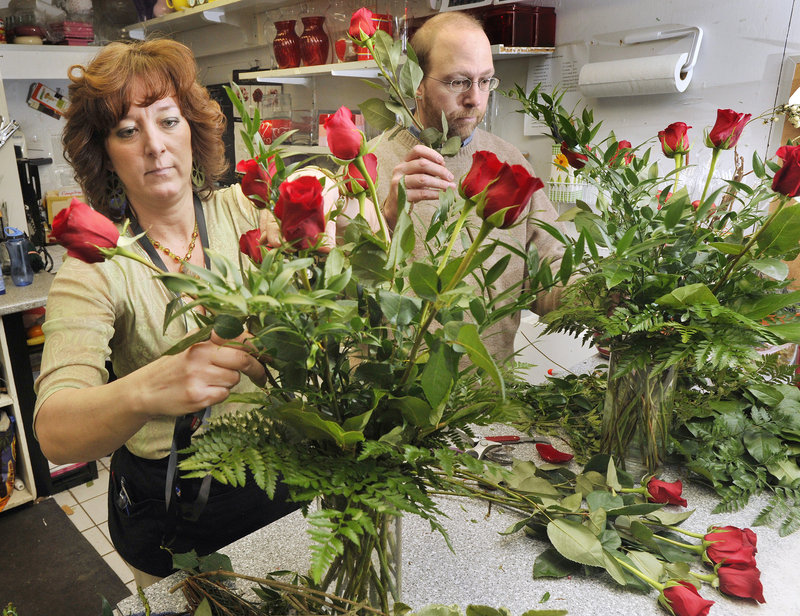PORTLAND – Rhonda Davis handed me a Swiss Army knife and told me to be careful. For added emphasis, she showed me some impressive scars on her arms from her 20-plus years as a florist.
“You’re cutting all day long, trying to get 30 or 40 arrangements done, you’re bound to slip sometimes,” said Davis, 45, the manager at Harmon’s & Barton’s flower shop on Congress Street. “People think this is a glamorous job, but it’s physical and you’ve got to move.”
I learned that part first-hand when I was putting together an arrangement of a dozen roses alongside Davis the week before Valentine’s Day.
I found that a dozen roses translated into several dozen stems. That’s because the vase also contained six or more pieces of four or five kinds of greens, plus a little pink flower called waxflower.
Each stem placed in the vase required a fresh cut at the bottom — so water could soak in — plus worn-looking or low-hanging foliage had to be trimmed, and the greens or flowers had to be placed in a such a way that they would not make the arrangement look crowded.
So as I tried to do each step to the best of my ability, Davis reminded me that if I were a real florist, I wouldn’t have the luxury of time.
“On Valentine’s Day we’ll be really moving all day, so you’d have to move,” said Davis.
On or about Valentine’s Day — which is today, husbands and boyfriends — Harmon’s & Barton’s will be making about 1,200 deliveries with 15 trucks, owner Dan Kennedy told me. (The store also has a Westbrook location as well as a sister flower shop, Sawyer & Co.)
The first thing I had to master before making a rose arrangement was the use of a Swiss Army knife. Davis showed me how to hold a stem in my hand, bend it just slightly and flick the knife underneath the stem so it cuts quickly at an angle.
When cutting the roses, she told me it was important to put a freshly cut rose directly into water. If too much air gets in the stem, it can be bad for the rose.
“If you get a rose that’s drooping over to one side, that probably means someone cut it, put it down, had a conversation and forgot it for a little while,” said Davis. “So put your rose in the water right away.”
I did. In fact, I practically knocked over the vase full of water doing so.
Davis told me that if I ever did have a drooping rose, it wasn’t necessarily dead. She said that you can take that drooping rose and re-cut the stem underwater. The water flowing into the stem will often bring the rose back to a healthy state.
The other important point Davis told me about was to count out the 12 roses before you start arranging. Set them aside and make sure there are indeed 12. Because there’s “nothing worse than an arrangement with 11 roses in it.”
The arrangements we were working on would sell for $79.95, so I felt compelled to make sure they included every last rose.
As we worked on two rose arrangements, side by side at a workbench, Davis and I just tossed extra leaves and stems on the floor. But it’s not like a cleaning fairy comes in later. The florists themselves will eventually have to clean up.
I spent so much time trying to get the greens and roses to be the right height that I didn’t really do the kind of arranging Davis advised me to.
She told me to keep spinning the vase around to see where the next rose or green should go, and to space them out. That was OK, Davis said, because you can always go back afterward and rearrange things later.
I also spent a little time at the store’s front counter, wrapping some orchids for a woman. Nancy Dean, who was manning the counter that day, asked the woman where she was taking the flowers and when she’d be going there. It was 11 a.m., and the customer told Dean she would be bringing the orchids to her parents around 11:30 a.m.
This was important information.
“If she wasn’t going for a couple hours, we’d put these (water sticks) on them. But those don’t last all day, so it’s important to find out from a customer how long it will be before the flowers reach their destination,” said Dean.
And this time of year, it’s important to tell people not to leave flowers in their car all day, with temperatures in the teens and 20s. The flowers at Harmon’s & Barton’s are kept in coolers with temperatures in the 30s and 40s.
Back in the workroom with Davis, I spent a lot of time trimming and cutting the greens that went with the roses. For one particular kind of plant that we were working with, Davis said it would be quicker to just run your fingers along the stem to pull off unwanted foliage. She cautioned me that it might hurt, but it didn’t hurt her.
“I have man hands from doing this so long,” she said.
I’m a man, I thought to myself. I can do that. It did hurt a little, but the biggest problem I had was applying enough pressure with my fingers to pop the leaves off.
So I picked up some clippers and used those instead.
Sometimes it is better for beginners to use clippers, Davis told me.
Staff Writer Ray Routhier can be contacted at 791-6454 or at:
rrouthier@pressherald.com
Send questions/comments to the editors.



